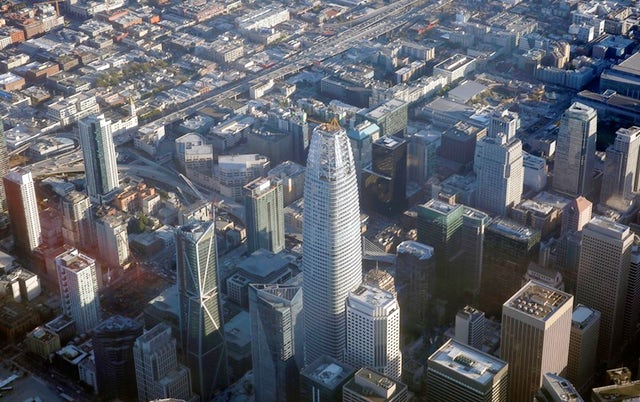The Salesforce Tower in San Francisco is installing a water recycling system to treat gray water and black water from the building, reducing the need for 30,000 gallons of freshwater a day, writes Ceres’ Kirsten James.

An aerial view of the Salesforce Tower, the tallest building in San Francisco. The tower will utilize a state-of-the-art recycled water treatment system.Tayfun Coskun/Anadolu Agency/Getty Images
San Francisco’s newest skyscraper, Salesforce Tower, is a first in many ways.
At 1,070ft, it is the tallest building in the city, and except for the spire on the Wiltshire Grand in Los Angeles, it’s the tallest west of the Mississippi. It is the first thing seen by travelers approaching the city from any direction, rising above the city’s fog.
Of particular interest to me, Salesforce Tower will also house the largest water recycling system in a commercial high-rise building in the United States. A black-water system will recycle all of the water used in the building to be available again for nonpotable uses, saving about 30,000 gallons of freshwater a day.
In a state that just experienced a severe five-year drought, it’s also an example of the trend we are seeing of businesses being part of the solution to water issues. Companies realize they can be an important player in helping to build urban resilience.
“We know that times of drought will one day return to this region, plus it’s always responsible to conserve precious resources,” Sunya Ojure, senior manager of sustainability at Salesforce, told me. “The black-water system in Salesforce Tower reinforces the notion that businesses can be powerful platforms for change.”
The black-water recycling system in the Salesforce Tower will collect wastewater from sources such as rooftop rainwater collection, showers, sinks, toilets, urinals and cooling towers, then treat and recirculate the water through a separate pipe system to serve nonpotable uses in the building that include flushing toilets, irrigation and operating cooling towers, Salesforce says. The system is not yet fully in place.
The technology is a membrane bioreactor, which treats wastewater onsite through a robust multistep process that’s a combination of membrane-based microfiltration or ultrafiltration and a biological wastewater treatment process.
Salesforce expects that the black-water recycling system, once fully completed, will reduce the building’s use of city-supplied potable water by 76 percent, helping San Francisco in its aim to conserve water. It will also cut the amount of wastewater sent to the city’s sewer.
The city of San Francisco passed an ordinance a few years ago requiring gray-water recycling in all new commercial building developments larger than 250,000 square ft. That gray-water recycling mandate says that for any large building receiving a permit after November 2016, developers must “install and operate an onsite nonpotable water system to treat and reuse available gray water, rainwater and foundation drainage for toilet and urinal flushing and irrigation.”
Salesforce Tower goes beyond the ordinance in that all water is recycled, including water that goes down sink drains and toilets, so-called black water, and treated for use in nonpotable purposes. Black-water recycling is often more than project proponents want to pursue due largely to the added regulatory hurdles of recycling toilet and shower water.
The city provided a grant to Salesforce and its developer, Boston Properties, to help build the black-water system – it’s the first partnership in the U.S.between a city government, a building owner and a tenant to support onsite black-water recycling and reuse in a commercial high-rise building.
“I would recommend to any company looking to install any sustainability feature in a new or existing building to have candid discussions with their local government officials and partners about the need for such technologies,” Ojure said. “Incorporate everyone from the early stages of planning to ensure alignment throughout the process.”
Ceres recently conducted an informal survey of its Connect the Drops partner companies – several dozen large companies that work collectively to ensure sustainable water supplies in California – to better understand their ambitions for recycling water and any barriers they may be facing.
A majority of the companies have already put in place or are considering installing water recycling systems – whether in their office buildings or agricultural or manufacturing facilities. But it isn’t always easy to implement water recycling, especially since few municipalities offer the level of assistance and regulatory support that San Francisco does for such projects.
California state senator Scott Wiener of San Francisco introduced Senate Bill 740 last year to set health and safety standards for onsite water reuse in the hopes that recycled water projects elsewhere in the state could avoid excessive regulatory obstacles. His bill, if it becomes policy, could potentially spur growth in distributed recycled water projects statewide.
Salesforce says the 30,000 gallons a day of freshwater it expects the Tower’s black-water recycling system to save adds up to 7.8 million gallons a year.
Salesforce Tower, in its many iconic ways, may with luck serve as an inspiration to developers of other commercial buildings to include similar black-water recycling systems. Collectively, such systems could go a long way in helping conserve potable water, a precious resource facing ever increasing demand.
Source: https://www.newsdeeply.com/
Dear User/Visitor! Please, answer on our questions: tick off one of the positions – your answer will make us able to improve our site and make it more interesting and useful!

